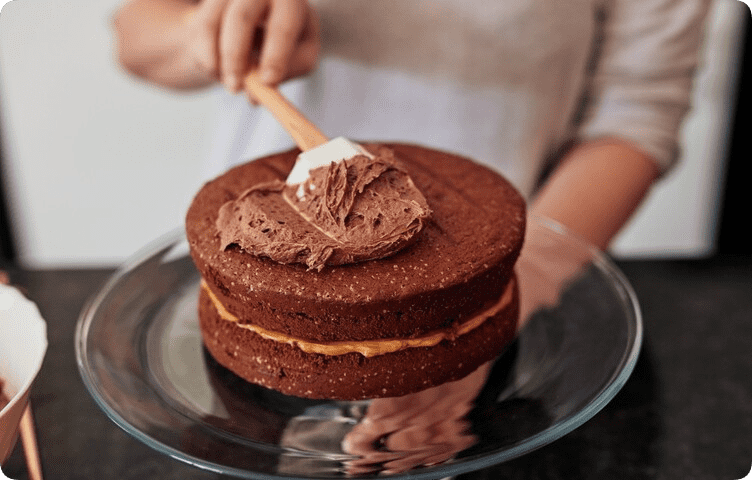Flip pancakes in a frying pan, cover a homemade cake with cream, stir a salad - these tasks are difficult to cope with without a kitchen spatula . There are more than a hundred versions of this handy device: metal and plastic, flat and curved, with slots and holes. How to choose the right accessory for your kitchen? First, get to know its types and features!
Types of blades by material
The first versions of the instrument, which appeared at the beginning of the 16th century, were exclusively metal. It is not surprising if you consider that the prototype of the culinary spatula was a Roman sword with a wide blade. Today, the choice of materials from which kitchen utensils are made has expanded significantly - from stainless steel to bamboo.
Plastic
Due to their low price, plastic tools are most often found in modern kitchens. They are durable, easy to use, and easy to clean. Thin edges allow for delicate cooking operations, such as flipping thin pancakes. But most types of plastic cannot withstand high temperatures, so the spatula may melt inside a heated frying pan.
Metal
Metal utensils are the most durable, as they are not damaged when heated. It is suitable for turning steaks and cutlets, both in regular dishes and on the grill. You can use the sharp edge of the tool to check the degree of doneness of the meat. But it is not recommended to use metal accessories with non-stick frying pans, as they will scratch the coating.
Silicone

Lightweight and flexible silicone products cope with many different culinary tasks. They withstand high temperatures, mix the dough well and distribute the cream over the baking surface. But using a flexible spatula is inconvenient to remove food stuck to a baking sheet or grill pan. Silicone has another significant disadvantage - it quickly absorbs odors, so it requires regular washing.
As an alternative, you can use utensils made of another high-strength alloy - nylon. This material is more rigid, and kitchen spatulas made from it easily turn fried food. But nylon tools are less heat-resistant - at temperatures above +200ᵒ C they melt.
Tree

Adherents of a healthy diet prefer wooden spatulas , since they do not contain chemical dyes. The wood is resistant to high temperatures and does not damage non-stick cookware. The natural wood pattern gives the products an aesthetic appearance that harmonizes with the interior in the Scandinavian, ecological, Provencal style. But wooden utensils easily absorb germs and particles of raw foods, so they need careful care.
Types of blades by shape
There are three main types of instrument:
Flip-shaped - consists of a long handle and a base widened at the bottom. Such products can be solid or with slots. The tip is usually pointed, which makes it easier to turn food. Used in the process of preparing scrambled eggs, vegetables, cutlets, grilled cheese;
The palette knife is reminiscent in shape of its ancient prototype, a combat sword. The base is long and elongated, with a rounded tip. The product is used for spreading glaze, cream, cream cheese;
Scraper - equipped with a small rectangular base with a sharp edge. Used for mixing salads, sauces, dough, preparing omelettes and pancakes.
An interesting type of tool is tongs, consisting of two shovels. They help to grip pies, pieces of fish, and meat while cooking on the grill or in a regular frying pan. The blades of the tongs may be the same or vary in shape.
Types of blades by purpose
The tool is considered universal, as it is used for various culinary operations - turning, mixing, chopping, serving. But for specific dishes you have to select special tools, for example:
- barbecue, grill - a large blade-shaped shovel with slots and a slightly curved handle;
- cakes - a narrow palette knife with a curved handle. With this tool you can make a perfectly smooth creamy coating.e, apply mastic or glaze.
- soft cheese - an instrument with an acute-angled base and a straight handle;
- fried fish - a trapezoid-shaped blade with long slits;
- pancakes - any heat-resistant product with a wide base and a pointed edge will do.
To properly serve dishes to guests, use a narrow spatula with a rounded edge. You can use it to spread mashed potatoes, spread cream cheese, and separate pieces of pies and cakes.
Rules for the care and storage of kitchen spatulas
Wooden and bamboo utensils require the most careful care. Wooden kitchen accessories cannot be washed in the dishwasher. Immediately after use, wash them with hot water and a mild detergent and wipe dry.
To prevent odors from being absorbed, regularly wipe the instrument with a slice of lemon. Once a year, lubricate wooden spatulas and spoons with warmed walnut oil. This treatment perfectly protects the wood from rotting and cracking.
Kitchen appliances made of plastic, silicone and stainless steel are considered the easiest to clean. They can be washed by hand and in the dishwasher.
But silicone products strongly absorb odor, so they need to be wiped with lemon juice from time to time. If stains appear on the surface, soak the instrument in hydrogen peroxide for a day. Then wipe with a thick mixture of baking soda and water, wash with soap and dry thoroughly.
The durability of blades largely depends on where they are stored. If the tool is used frequently, it can be hung on a hook above the sink. This option is not suitable for wooden and bamboo products, since moisture gradually destroys the wood. A convenient storage option is a wooden or metal container on a table or nightstand.
Some types of blades are rarely used. For example, grill or pastry utensils . Such items are stored in drawers or on a hanging bar.
















































/https%3A%2F%2Fcomplexbar.com%2Fimages%2Fblog%2F132%2FSpatula1-2.png)
/https%3A%2F%2Fcomplexbar.com%2Fimages%2Fblog%2F246%2Fsirop_scale_2400.jpeg)
/https%3A%2F%2Fcomplexbar.com%2Fimages%2Fblog%2F246%2Fkofe-vostochniy.jpg)
/https%3A%2F%2Fcomplexbar.com%2Fimages%2Fblog%2F245%2Fpexels-jason-villanueva-851555.jpg)
/https%3A%2F%2Fcomplexbar.com%2Fimages%2Fblog%2F246%2F2024-04-09_17.22.54.jpg)
/https%3A%2F%2Fcomplexbar.com%2Fimages%2Fblog%2F246%2F2024-04-09_17.22.47.jpg)
/https%3A%2F%2Fcomplexbar.com%2Fimages%2Fblog%2F246%2FCODE_anons_foamydrops_752%D1%85480_eng.jpg)
/https%3A%2F%2Fcomplexbar.com%2Fimages%2Fblog%2F246%2FAlina_752%D1%85480_eng.jpg)
/https%3A%2F%2Fcomplexbar.com%2Fimages%2Fblog%2F246%2F2024-04-09_17.23.22.jpg)
/https%3A%2F%2Fcomplexbar.com%2Fimages%2Fblog%2F246%2F2024-04-09_17.23.28.jpg)
/https%3A%2F%2Fcomplexbar.com%2Fimages%2Fblog%2F246%2F2024-04-09_17.23.35.jpg)
/https%3A%2F%2Fcomplexbar.com%2Fimages%2Fblog%2F246%2Fdrinksome_752%D1%85480_eng.jpg)
/https%3A%2F%2Fcomplexbar.com%2Fimages%2Fblog%2F246%2Fnude_752%D1%85480_eng.jpg)
/https%3A%2F%2Fcomplexbar.com%2Fimages%2Fblog%2F246%2F752%D1%85480_eng__1_.jpg)
/https%3A%2F%2Fcomplexbar.com%2Fimages%2Fblog%2F246%2F752%D1%85480_eng.jpg)
/https%3A%2F%2Fcomplexbar.com%2Fimages%2Fblog%2F246%2FStudioRaw_752%D1%85480_eng.jpg)
/https%3A%2F%2Fcomplexbar.com%2Fimages%2Fblog%2F246%2FDoppio_tea_752%D1%85480_eng.jpg)
/https%3A%2F%2Fcomplexbar.com%2Fimages%2Fblog%2F246%2FTognana_Stars_Stripes_752%D1%85480_eng.jpg)
/https%3A%2F%2Fcomplexbar.com%2Fimages%2Fblog%2F246%2FRona_752%D1%85480_eng.jpg)
/https%3A%2F%2Fcomplexbar.com%2Fimages%2Fblog%2F246%2FDoppio_vending_752%D1%85480_eng.jpg)
/https%3A%2F%2Fcomplexbar.com%2Fimages%2Fblog%2F246%2FEssence_sukhie_smesi_752%D1%85480_eng.jpg)
/https%3A%2F%2Fcomplexbar.com%2Fimages%2Fblog%2F246%2FODK_sukhie_smesi752%D1%85480_eng.jpg)
/https%3A%2F%2Fcomplexbar.com%2Fimages%2Fblog%2F246%2Funiforma-barmena.jpg)
/https%3A%2F%2Fcomplexbar.com%2Fimages%2Fblog%2F246%2Fkak-nanyat-barmena.jpg)
/https%3A%2F%2Fcomplexbar.com%2Fimages%2Fblog%2F246%2Fsirop_scale_2400.jpeg)
/https%3A%2F%2Fcomplexbar.com%2Fimages%2Fblog%2F246%2FPeugeot_Anons_Paris_U%27Select_Line_Daman_752%D1%85480_eng.jpg)
/https%3A%2F%2Fcomplexbar.com%2Fimages%2Fblog%2F246%2Fkofe-vostochniy.jpg)
/https%3A%2F%2Fcomplexbar.com%2Fimages%2Fblog%2F246%2FMadler.jpg)
/https%3A%2F%2Fcomplexbar.com%2Fimages%2Fblog%2F246%2Fprofbartender_glavn.jpeg)